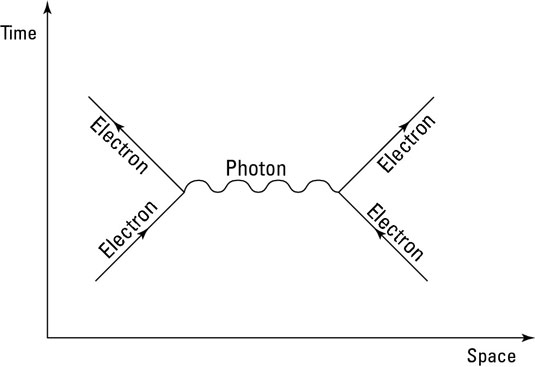Quantum electrodynamics is the study of the interactions between electrons and their interactions with electromagnetic fields. It's involved in many different types of phenomena, including laser operation, various other forms of radiation, atomic structure, relativistic effects, etc.
There are lots of ways you can try to describe these interactions, but the most successful one is Feynman's path integral formulation.
This is a really weird way of doing things. The electromagnetic field itself isn't even treated as a fundamental object; it's treated as an effective modification or artifact of something more fundamental called "electrons." What are electrons? They're infinitesimal points that follow lines through time. Once upon a time, they were treated both as particles and waves with different interpretation depending on where they were observed...in the end though, it turned out that electron waves were simply disturbances in fields, so there were no actual physical things there at all. These disturbances are inherently quantummechanical phenomena - the smallest possible disturbance is a quanta of energy, which is also quantized.
Electrons are the lines on which these disturbances happen. They're actually lines in Feynman's path integral formulation, not just things that have positions at different times. The paths of electrons are more simply described as their "worldlines" - i.e., what you'd get if you took a spacetime diagram of the history of an electron and drew it out - something like this:
Electrons can be created or destroyed by colliding with other particles, but only if the sum total energy remains unchanged by doing so - otherwise, conservation laws would be violated. This energy added to the system must go somewhere, though conservation of momentum has to hold, so it gets converted into new photons.
Photons are particles of light, but they're not like your typical "elementary" particle that might interact with other stuff on very short distance scales (like the size of an atomic nucleus). Instead, photons are more like "super-particles." They form all sorts of diffeomorphism-invariant composite states called polarizations - things like electron/positron pairs or quark/anti-quark condensates can be associated with different polarizations of photons. (The reason why photons create these composite states is because the energy they carry happens to be just right for this purpose.)
Superimposed on top of these interactions between electrons and photons are some short-range nuclear interactions. Instead of thinking purely in terms of "force" from a distance, consider the nature of some large nucleus hitting some other nucleus - they can't just pass right through each other. If there's no electron on either side to do the screen-wipe at the last minute and create an interaction due to momentum transfer, then two nuclei will bounce off each other like billiard balls or explode in a burst of neutrons and gamma rays. (The force is still long range though; it takes time for things to go "boom.")
All of these different types of interactions - electron/photon, photon/photon, electron/nucleus - are distinct from each other in Feynman's path integral. In fact, you need to sum over all possible intermediate configurations between the initial and final states to get a complete picture of what happens. This is harder than it sounds because it involves summing over all possible deformations and translations of spacetime itself along with everything else which might happen and be important.
There are lots more details about renormalization and such which I'm deliberately leaving out here for brevity; you can find them elsewhere if you want to become a QED expert.

Comments
Post a Comment